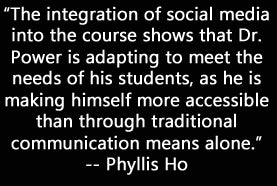Bill Power and the Power of Twitter
 |
|
Bill Power in Waterloo's Peter Russell Rock Garden |
Written by Bailey Jacobs, Special Projects (Teaching Stories), CTE.

Power’s hunt for “something better” has paid off. Beyond being “dynamic” and “scalable,” Twitter has the additional perk of being platform independent, which Power believes is a crucial component to technological communication. Understanding the busy schedule of his students, Power uses Twitter as a “direct pipeline” of information to them, wherever they may be. He states, “students shouldn’t have to pull in information—it should be pushed to them.” The automatic delivery feature of Twitter’s “push notifications” allows students to be informed without having to login and check the course page for updates. “Personally,” states Phyllis Ho, a student of Power's, “I check Twitter almost twice as often as I check LEARN, and would be more likely to read a course announcement through Twitter than LEARN.” For those students who choose to forego using Twitter for the course, the live Twitter feed is embedded directly in the course LEARN web page. Further, Power asks for his students’ Twitter usernames at the beginning of the term. Doing so allows him to monitor the Twitter group for the course and block anyone who is not one of his students, creating a safe space for his class to interact.
As many educators well know, if one student in a class of one hundred has a question there are likely numerous students with the same query. When a question is “tweeted,” Power, along with student users, can comment on the tweet “discussion board” style, with all updates being automatically delivered to the interested students. Student Phyllis Ho confides, “Emailing a professor can be a scary ordeal… with Twitter, you're confined to 140 characters so it lets you get right to the point and ask your question.” The image feature, where Twitter provides the option to attach a photograph to a tweet, is often utilized by Power in the equation-heavy Chemistry course of Thermodynamics. Students struggling with an equation can take a picture of their work, attach it to their tweet, and receive guidance from Power, allowing for a highly communicative teaching experience.
Power understands that nowadays, as technology is constantly advancing, almost every university student is “connected” in some way. One of the main technological devices that students use to stay connected is cell phones. “They have such an intelligent tool in the palm of their hands,” states Power, and it is undeniable that cell phones are present and active in the classroom. “Educators,” he says, “have to embrace technology rather than ignore it. We might as well get our students to use it for ‘good.’”
Read more Teaching Stories
More Resources
CTE has developed more than 100 Teaching Tips. Each one is a succinct document that conveys useful ideas and practical methods for effective teaching. Some of the Teaching Tips that are relevant to the strategies mentioned in this Teaching Story include the following: